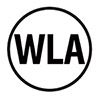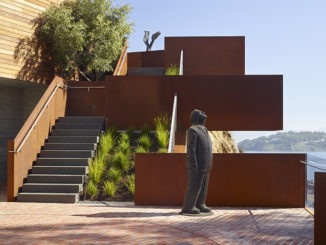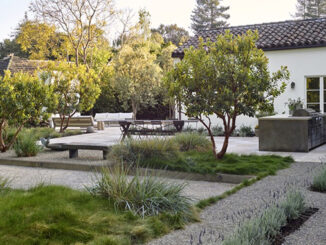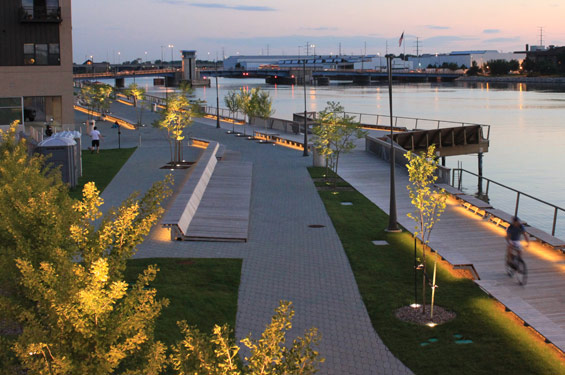
The CityDeck is the heart of a multi-phase redevelopment project along Green Bay’s Fox River. The project aims to allow for significantly increased access to the river and to diversify social and ecological life along it.
EXISTING CONDITIONS + CHALLENGES
The site is a 2-acre strip of land, typically measuring 50 to 60 feet wide, that runs along the edge of the Fox River in downtown Green Bay. It is about one-quarter-mile in length and is situated between two bridges that cross the river. At the project’s beginning, adjacent parcels were empty, abandoned (a large yellow warehouse), or in use as parking lots. Nearby buildings turned their back on the riverfront. Unsurprisingly, there was little social or civic life here, and no reason to visit; the elevated walk along existing bulkhead walls prevented any direct access down to the river—as well as up to the city from boats.
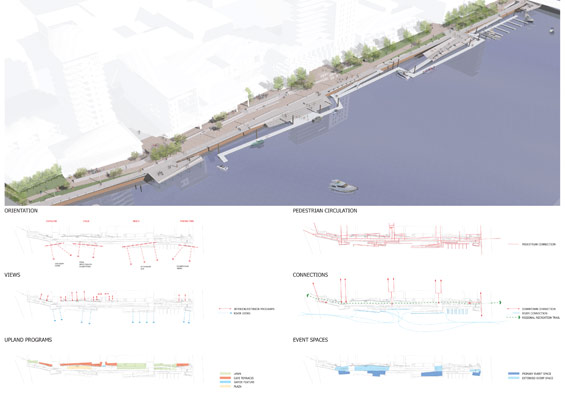
DESIGN STRATEGY
To address these challenges, the design team tasked itself with identifying broader urban design strategies for new open space and development along the river. These financial and programmatic ideas
would positively transform about six square blocks of urban fabric and would reach back into downtown. The team sought to reconnect city streets and create new development parcels where symbiotic
programmatic relationships between proposed buildings and open space would reinforce one another. Phase one of The CityDeck grew out of these urban design studies and strategies, which are now being
developed in parallel with the open space. All was developed in close collaboration with City leaders and various local, regional, state, and federal regulatory agencies—as well as with the broader public.
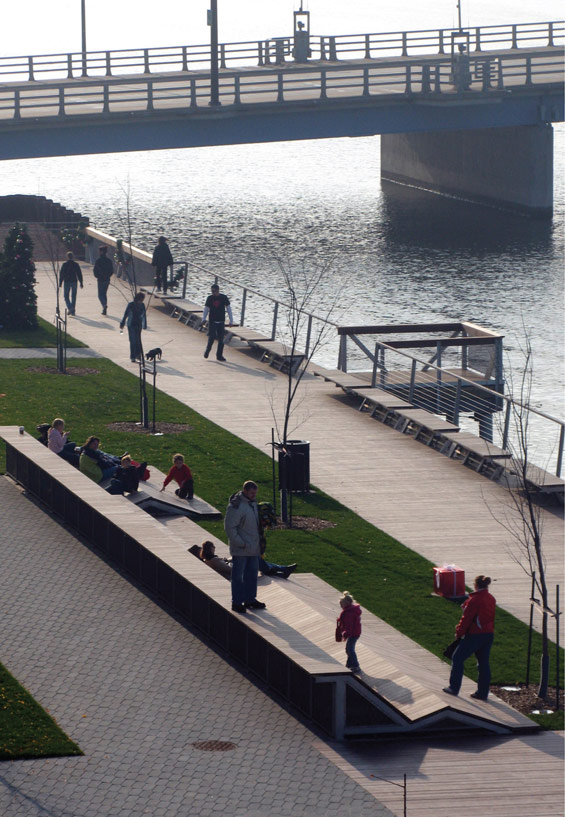
DESIGN ELEMENTS
As conceived, Phase 1 of The CityDeck negotiates an infrastructural landscape of physical, environmental, and code complexities, and responds to the need for social and economic re-activation. The project establishes a new downtown waterfront; a new front porch for the city on the region’s most precious environmental and economic resource, the Fox River.
The project starts as a simple boardwalk deployed at the edge of city and river. The highly articulated wooden boardwalk undulates, folding in response to technical, code, and programmatic issues. At the scale of the human body, these folds create diverse seats, benches, and chaise lounges that allow forchoice and flexibility: some are close to the water, others further back but overlooking it; some are clustered and assembled in long rows, while others are a bit more solitary. The idea was to give people many choices about where to sit, depending on their own desires, their body type, their mood, and their attraction to various ambient light, heat, or weather conditions.
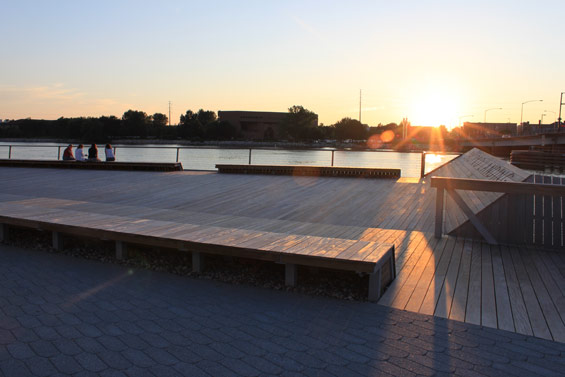
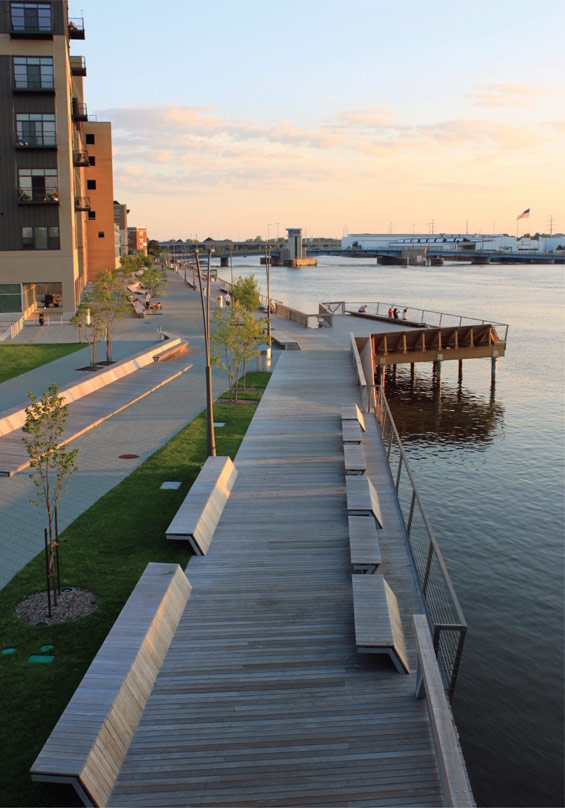
The wood surface folds up and over the existing bulkhead wall at the north end of the site, rising to form a dramatic overlook perched above the river on piles—a great place to watch passing lake barges and small recreational boats. At the city edge, the surface folds up again, affording adjacent buildings required protection from flooding and creating retail and dining terraces, seating, and communal chaise lounges looking out to the water. A flexible upland plaza floats atop fill between the perched terraces and the undulating boardwalk, creating a free-zone to be inhabited by festivals, vendors, and spontaneous activity; it doubles as an informal amphitheater for performances and is marked at its southern end by an interactive play fountain.
Lawns are located at both north and south ends of the project, allowing for casual play and picnicking. Groves and scatterings of gingkos, elms, and coffeetrees offer shade in the hot summer sun and reduce adjacent buildings’ cooling loads. During football season, the trees turn bright yellow, half of the green and gold color scheme of the city’s beloved Green Bay Packers football team; the green is manifest in custom-designed concrete pavers (with a green aggregate), shaped to resemble fish scales and perforated to allow for stormwater infiltration.
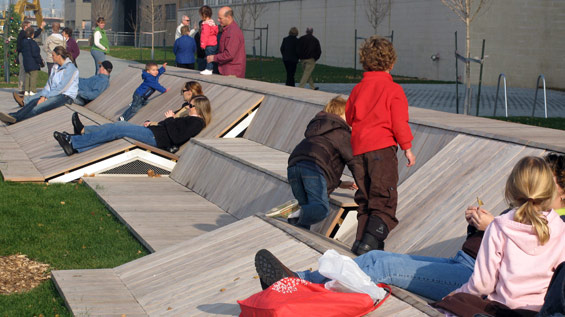
PROGRAMMING
The City and various non-profit civic organizations have taken to programming the space almost yearround. St Patrick’s Day and Christmas Parades end or pass by here; the marathon traverses the length of the project. “Fridays on the Fox” (summer entertainment and music events), “Dine on the Deck” (regular Wednesday noon lunch events), Irish dance troupes, dueling pianos, at least one wedding, and an Elvis sighting are among the activities that continue to attract crowds. The CityDeck counted more than 100,000 visitors in 2010.
Future phases of the project are currently underway and will include two new large over-water structures (amphitheater steps and stage, and an urban beach), as well as docks for boaters. Since concept design, a new apartment building with ground-floor retail space, a new condominium, and a new bank headquarters and office building have been constructed to reinforce the physical and programmatic goals of The CityDeck. At the center of the adjacent site, a mixed use project, with apartments, offices, a restaurant, cafes, and a new children’s museum, is now under construction.
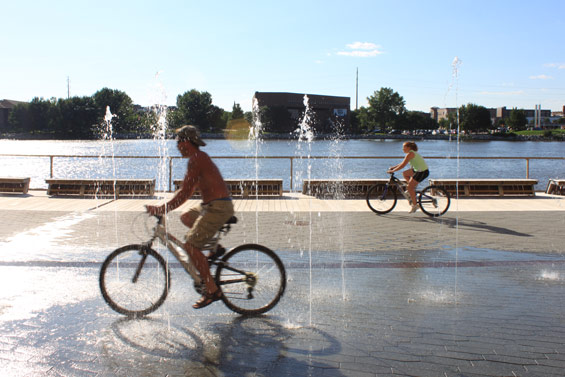
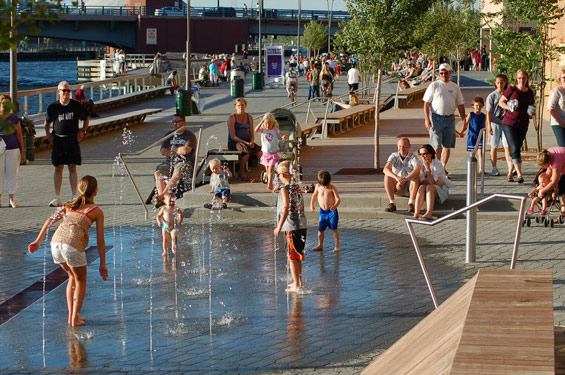
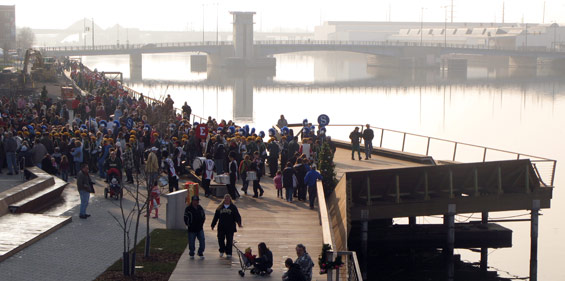
Project Name: The CityDeck
Completion Date: Phase 1 opened in stages in 2009 and 2010. Phases 2 and 3 are scheduled for
completion in 2011-2012.
Location: Green Bay, Wisconsin, USA
Size: Phase 1: 2.5 acres; 5 acres total
Designer: Stoss Landscape Urbanism
Chris Reed, principal, lead designer
Scott Bishop, project manager
Design Team: Tim Barner, Cathy Braasch, Steve Carlucci, Jill Desimini, Adrian Fehrmann, Carl
Frushour, Kristin Malone, Chris Muskopf, Susan Fitzgerald, Jana Kienitz, Lisl Kotheimer, Bryan
Miyahara, Graham Palmer, Megan Studer, Sarah Wright
Collaborators: Vetter Denk, urban design
GRAEF Anhalt Schloemer and Associates, structural engineering
STS Consultants/AECOM, civil and geotechnical engineering
Light THIS! , lighting design
Pine + Swallow, soil science
Clark Dietz, electrical and plumbing
WF Baird Associates, cost
Photographer/s: as noted
